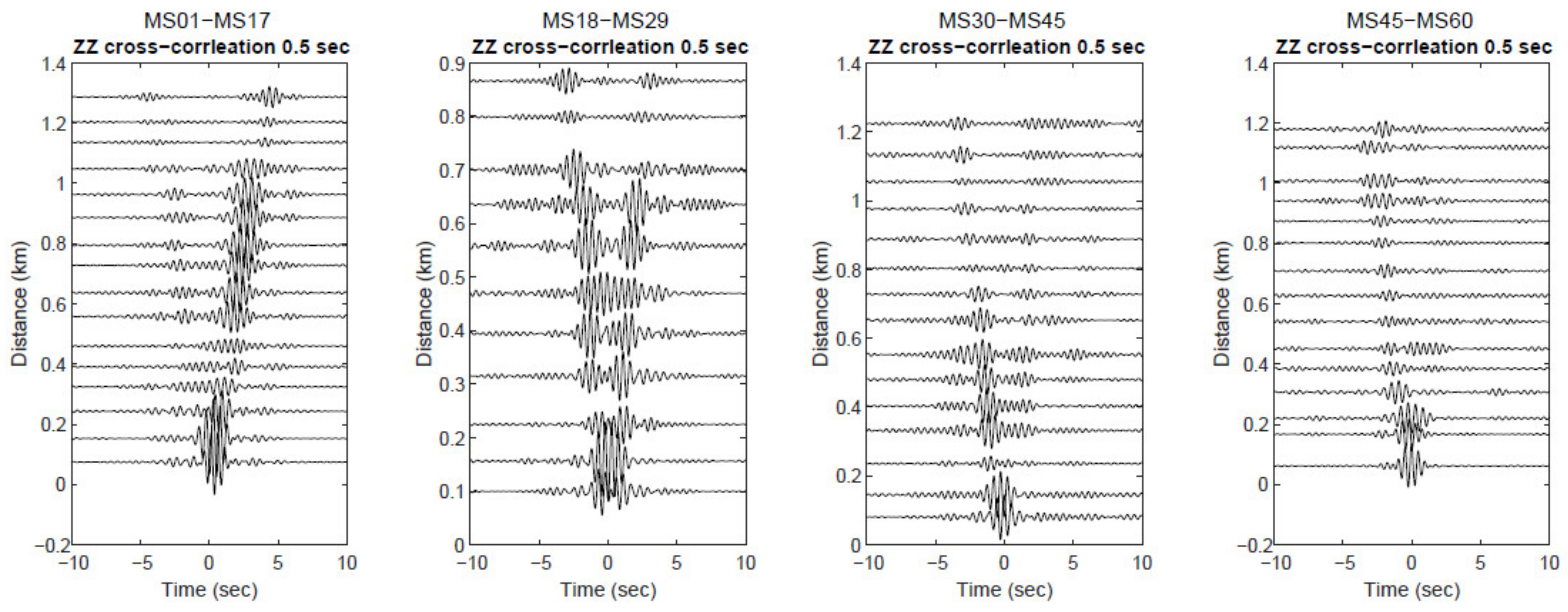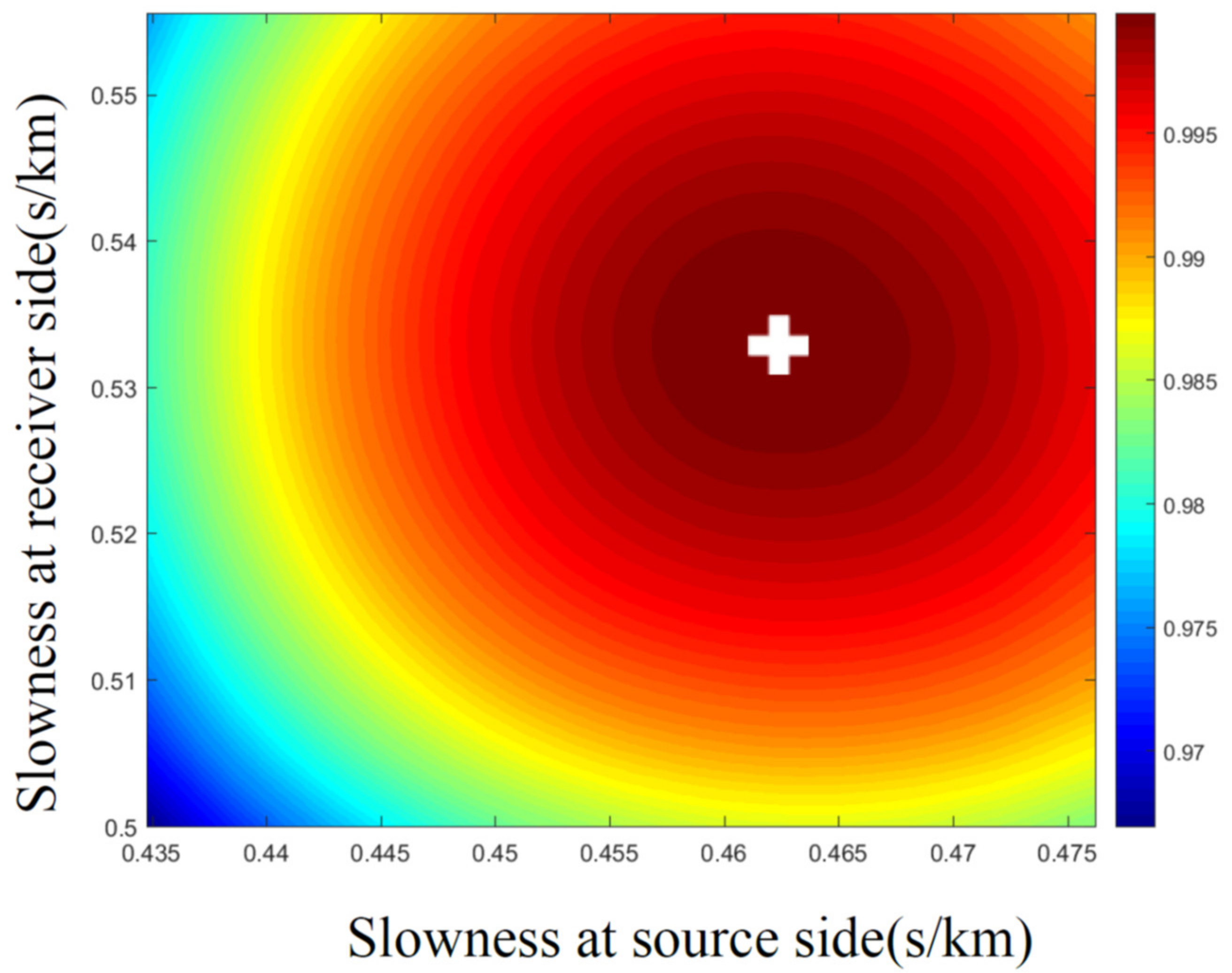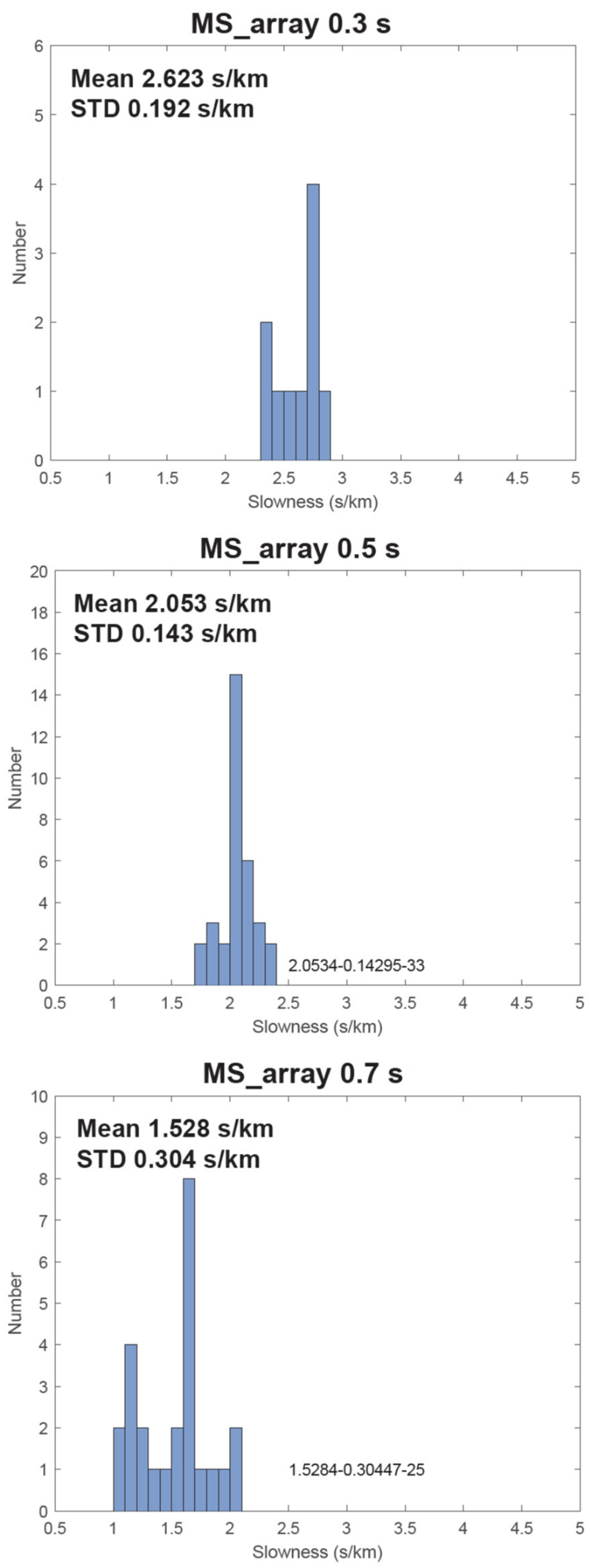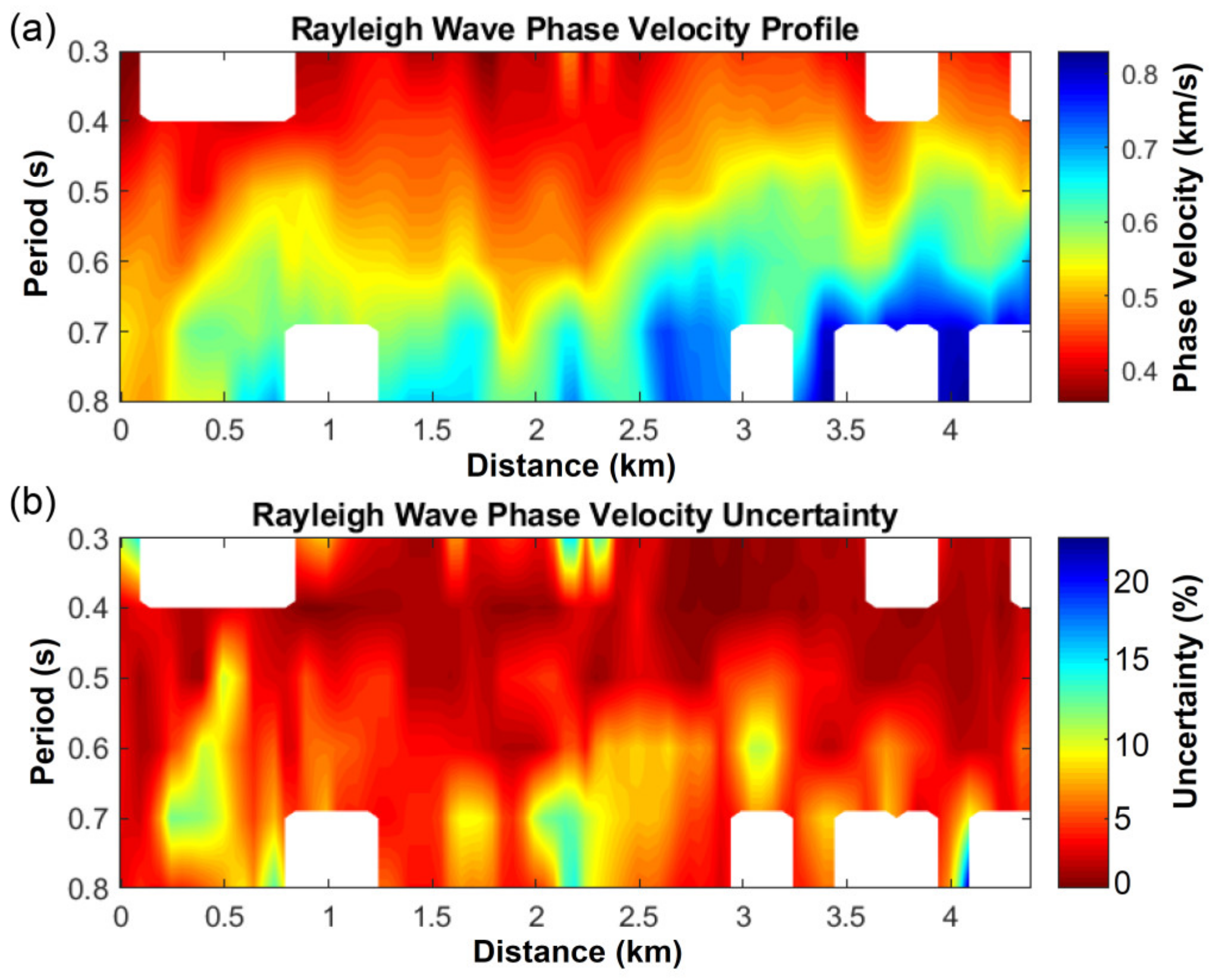The Investigation of Shallow Structures at the Meishan Fault Zone with Ambient Noise Tomography Using a Dense Array Data
Abstract
:1. Introduction
2. Materials and Methods
2.1. Ambient Noise Cross Correlations
2.2. Double Beamforming Tomography
2.3. Shear Velocity Inversion
3. Results
3.1. Phase Velocities and Uncertainties
3.2. Phase Velocities and Uncertainties
4. Discussion
5. Conclusions
Author Contributions
Funding
Data Availability Statement
Acknowledgments
Conflicts of Interest
References
- Finzi, Y.; Hearn, E.H.; Ben-Zion, Y.; Lyakhovsky, V. Structural properties and deformation patterns of evolving strike-slip faults: Numerical simulations incorporating damage rheology. Pure Appl. Geophys. 2009, 166, 1537–1573. [Google Scholar] [CrossRef] [Green Version]
- Meyer, S.E.; Kaus, B.J.P.; Passchier, C. Development of branching brittle and ductile shear zones: A numerical study. Geochem. Geophys. Geosyst. 2017, 18, 2054–2075. [Google Scholar] [CrossRef]
- Omori, F. Preliminary note on the Formosa earthquake of March 17, 1906. Bull. Imp. Earthq. Inves. Comm. 1907, 2, 53–71. [Google Scholar]
- Bonilla, M.G. A review of recently active faults in Taiwan. In U.S. Geological Survey Open-File Report 75-41, Version 1.1; USGS: Reston, VA, USA, 1975; p. 43. [Google Scholar]
- Hsu, T.L.; Chang, H.C. Quaternary faulting in Taiwan. Mem. Geol. Soc. China 1979, 3, 155–165. [Google Scholar]
- Lin, C.-W.; Chang, H.-C.; Lu, S.-T.; Shih, T.-S.; Huang, W.-C. An Introduction to the Active Faults of Taiwan, 2nd ed.; Central Geological Survey Special Publication: New Taipei, Taiwan, 2000; pp. 1–122. (In Chinese)
- Chen, H.-W.; Shih, T.-S.; Shao, P.-H.; Huang, P.-H.; Chang, H.-C. The Study of Meishan Fault from Dalin and Zhongkeng Quaterary Strata Profiles; Annual Report of Central Geological Survey; Central Geological Survey: New Taipei, Taiwan, 2001; pp. 12–15. (In Chinese)
- Shih, R.-C.; Chen, P.-H.; Lu, M.-T.; Chen, W.-S. Construction of Active Fault Database Plan Form Seismic and Geological Surveys—Shallow Geophysical Exploration (1/5); Annual Report of Central Geological Survey; Central Geological Survey: New Taipei, Taiwan, 2002; pp. 1–166. (In Chinese)
- Huang, C.-Y.; Shyu, C.-T.; Lin, S.B.; Lee, T.-Q.; Sheu, D.D. Marine geology in the arc-continent collision zone off southeastern Taiwan: Implications for Late Neogene evolution of the Coastal Range. Mar. Geol. 1992, 107, 183–212. [Google Scholar] [CrossRef]
- Chen, W.-S.; Yang, C.-C.; Shih, R.-C.; Yang, H.-C.; Yan, Y.-C.; Chen, Y.-G.; Chang, H.-C.; Lin, W.-H.; Lee, Y.-H.; Shih, T.-S.; et al. Structural Characteristics of the Chiuchiungkeng Fault. Cent. Geol. Surv. Spec. Publ. 2003, 14, 123–139. (In Chinese) [Google Scholar]
- Chen, W.-S.; Yu, N.-T.; Yang, H.-C. The Characteristics Investigation of Important Active Faults Research Project-Analysis and Evaluation of Active Faults (3/4); Final Report of Central Geological Survey; Central Geological Survey: New Taipei, Taiwan, 2013; pp. 1–98. (In Chinese)
- Wang, Y.; Lin, F.C.; Ward, K.M. Ambient noise tomography across the Cascadia subduction zone using dense linear seismic arrays and double beamforming. Geophys. J. Int. 2019, 217, 1668–1680. [Google Scholar] [CrossRef]
- Bensen, G.D.; Ritzwoller, M.H.; Barmin, M.P.; Levshin, A.L.; Lin, F.; Moschetti, M.P.; Shapiro, N.M.; Yang, Y. Processing seismic ambient noise data to obtain reliable broad-band surface wave dispersion measurements. Geophys. J. Int. 2007, 169, 1239–1260. [Google Scholar] [CrossRef] [Green Version]
- Harmon, N.; Gerstoft, P.; Rychert, C.A.; Abers, G.A.; Salas de La Cruz, M.; Fischer, K.M. Phase velocities from seismic noise using beamforming and cross correlation in Costa Rica and Nicaragua. Geophys. Res. Lett. 2008, 35, L19303. [Google Scholar] [CrossRef] [Green Version]
- Gatto, M.P.A.; Montrasio, L.; Zavatto, L. Experimental Analysis and Theoretical Modelling of Polyurethane Effects on 1D Wave Propagation through Sand-Polyurethane Specimens. J. Earthq. Eng. 2021, 1–24. [Google Scholar] [CrossRef]
- Wang, Y.; Lin, F.-C.; Schmandt, B.; Farrell, J. Ambient noise tomography across Mount St. Helens using a dense seismic array. J. Geophys. Res. Solid Earth 2017, 122, 4492–4508. [Google Scholar] [CrossRef]
- Yao, H.; van Der Hilst, R.D.; De Hoop, M.V. Surface-wave array tomography in SE Tibet from ambient seismic noise and two-station analysis—I. Phase velocity maps. Geophys. J. Int. 2006, 166, 732–744. [Google Scholar] [CrossRef] [Green Version]
- Yao, H.; Beghein, C.; Van Der Hilst, R.D. Surface wave array tomography in SE Tibet from ambient seismic noise and two-station analysis-II. Crustal and upper-mantle structure. Geophys. J. Int. 2008, 173, 205–219. [Google Scholar] [CrossRef] [Green Version]
- Herrmann, R.B. Computer programs in seismology: An evolving tool for instruction and research. Seismol. Res. Lett. 2013, 84, 1081–1088. [Google Scholar] [CrossRef]
- Yun, K.Y. A Study in the Conversion between P-Wave Velocity and Density Models of Yunlin and Chiayi Areas, Taiwan. Master’s Thesis, National Chung Cheng University, Chiayi, Taiwan, 2018. (In Chinese). [Google Scholar]
- Chen, W.-S.; Yang, C.-C.; Yang, H.-C.; Wu, L.-C.; Lin, C.-W.; Chang, H.-C.; Shih, R.-C.; Lin, W.-H.; Lee, Y.-H.; Shih, T.-S.; et al. Tectono-geomorphologic studies in the Chiayi-Tainan region in southwestern Taiwan and its implications for active structure. Bull. Cent. Geol. Surv. 2004, 17, 53–78. (In Chinese) [Google Scholar]
- Chen, W.-S.; Yeh, M.-G.; Yang, C.-C.; Shih, R.-C.; Lin, C.-W.; Hou, C.-S. Structural Studies of the Meishan Fault, Southwest Taiwan. Bull. Cent. Geol. Surv. 2006, 19, 135–151. (In Chinese) [Google Scholar]
- Liao, Y.W.; Ma, K.F.; Hsieh, M.C.; Cheng, S.N.; Kuo-Chen, H.; Chang, C.P. Resolving the 1906 Mw 7.1 Meishan, Taiwan, Earthquake from Historical Seismic Records. Seismol. Res. Lett. 2018, 89, 1385–1396. [Google Scholar] [CrossRef] [Green Version]
- Wang, C.-Y.; Lee, Y.-H. The Investigation form Seismic Survey; National Central University: Taoyuan, Taiwan, 2005. (In Chinese) [Google Scholar]
- Wilcox, R.E.; Harding, T.P.; Seely, D.R. Basic wrench tectonics. Aapg Bull. 1973, 57, 74–96. [Google Scholar]
- Woodcock, N.H.; Fischer, M. Strike-slip duplexes. J. Struct. Geol. 1986, 8, 725–735. [Google Scholar] [CrossRef] [Green Version]
- Dieterich, J.H.; Smith, D.E. Nonplanar faults: Mechanics of slip and off-fault damage. Pure Appl. Geophys. 2009, 166, 1799–1815. [Google Scholar] [CrossRef]
- Fang, Z.; Dunham, E.M. Additional shear resistance from fault roughness and stress levels on geometrically complex faults. J. Geophys. Res. Solid Earth 2013, 118, 3642–3654. [Google Scholar] [CrossRef]
- Wang, Y.; Allam, A.; Lin, F.C. Imaging the fault damage zone of the San Jacinto Fault near Anza with ambient noise tomography using a dense nodal Array. Geophys. Res. Lett. 2019, 46, 12938–12948. [Google Scholar] [CrossRef]
- Sun, W.-H. The Three-Dimensional Seismic Interpretation of Structure of the Meishan Fault Zone. Master’s Thesis, National Chung Cheng University, Chiayi, Taiwan, 2015. (In Chinese). [Google Scholar]
- Tsao, H.-C. Subsurface Image of the Meishan Fault and in Nearby Structure by Using the Seismic Reflection Data. Master’s Thesis, National Chung Cheng University, Chiayi, Taiwan, 2017. (In Chinese). [Google Scholar]
- Huang, W.-H. Integrated Interpretation of the Structure of the Meishan Fault by Using Seismic Exploration Data. Master’s Thesis, National Chung Cheng University, Chiayi, Taiwan, 2018. (In Chinese). [Google Scholar]
- Zheng, J.-Y. 3-D Shear Wave Shallow Crustal Structure at Meishan Fault Zone Using Ambient Noise Tomography. Master’s Thesis, National Central University, Taoyuan, Taiwan, 2018. (In Chinese). [Google Scholar]







Publisher’s Note: MDPI stays neutral with regard to jurisdictional claims in published maps and institutional affiliations. |
© 2022 by the authors. Licensee MDPI, Basel, Switzerland. This article is an open access article distributed under the terms and conditions of the Creative Commons Attribution (CC BY) license (https://creativecommons.org/licenses/by/4.0/).
Share and Cite
Wu, W.-J.; Su, C.-M.; Chen, C.-H. The Investigation of Shallow Structures at the Meishan Fault Zone with Ambient Noise Tomography Using a Dense Array Data. Appl. Sci. 2022, 12, 5847. https://doi.org/10.3390/app12125847
Wu W-J, Su C-M, Chen C-H. The Investigation of Shallow Structures at the Meishan Fault Zone with Ambient Noise Tomography Using a Dense Array Data. Applied Sciences. 2022; 12(12):5847. https://doi.org/10.3390/app12125847
Chicago/Turabian StyleWu, Wei-Jhe, Chien-Min Su, and Chau-Huei Chen. 2022. "The Investigation of Shallow Structures at the Meishan Fault Zone with Ambient Noise Tomography Using a Dense Array Data" Applied Sciences 12, no. 12: 5847. https://doi.org/10.3390/app12125847
APA StyleWu, W.-J., Su, C.-M., & Chen, C.-H. (2022). The Investigation of Shallow Structures at the Meishan Fault Zone with Ambient Noise Tomography Using a Dense Array Data. Applied Sciences, 12(12), 5847. https://doi.org/10.3390/app12125847




